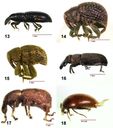Eurhoptus
Eurhoptus
Classification
- Phylum: Arthropoda
- Subphylum: Hexapoda
- Class: Insecta
- Order: Coleoptera
- Suborder: Polyphaga
- Superfamily: Curculionoidea
- Family: Curculionidae
- Subfamily: Cryptorhynchinae
- Tribe: Cryptorhynchini
- Subtribe: Tylodina
- Genus: Eurhoptus
Pronunciation
How to pronounce Eurhoptus: /jʊəˈɹɒptəs/
These audio files are automatically generated. While they are not always 100% accurate, they are a good starting point.
Images




Summary
Eurhoptus is a genus of hidden snout weevils within the Curculionidae family, containing several described species in North America and having a larger number of unidentified species. Recent taxonomic revisions have introduced new species and clarified existing classifications.
Physical Characteristics
1.8–3.2 mm in length
Identification Tips
Similar to other hidden snout weevils, characterized by their hidden snouts which are often not immediately visible due to their rounded bodies.
Habitat
Primarily found in the eastern United States and Mesoamerica, inhabiting various terrestrial environments.
Distribution
From the eastern United States to Mesoamerica.
Diet
Eurhoptus species are typically herbivorous, feeding on plant material.
Life Cycle
Details on the specific life cycle of Eurhoptus are not well-documented; hidden snout weevils generally undergo complete metamorphosis including egg, larval, pupal, and adult stages.
Reproduction
Reproductive behaviors specific to Eurhoptus are not extensively documented, though most weevils are known to lay eggs in or near their food source.
Predators
Specific predators of Eurhoptus are not noted; however, they are generally vulnerable to various insectivorous species and natural enemies.
Ecosystem Role
As herbivores, they play a role in their ecosystems by influencing plant community dynamics and serving as prey for various predators.
Collecting Methods
- Sweeping vegetation
- Hand collection from host plants
Preservation Methods
- Pinning
- Alcohol preservation
Evolution
Eurhoptus is part of the subfamily Cryptorhynchinae, which includes diverse weevil species adapted to various ecological niches.
Similar Taxa
- Other genera within the Curculionidae family
- Hidden snout weevils
Misconceptions
Due to their small size and similarity to other beetles, they are often overlooked or misidentified as other small weevils.
Tags
- Coleoptera
- Weevil
- Eurhoptus
- Curculionidae
- Adult insects